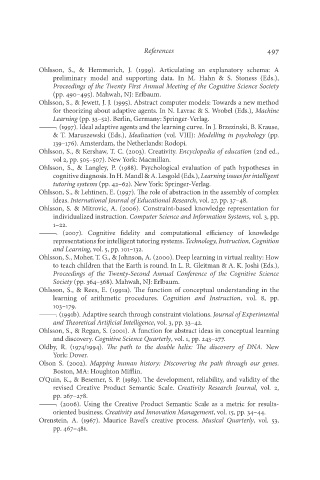Page 514 - Deep Learning
P. 514
References 497
Ohlsson, S., & Hemmerich, J. (1999). Articulating an explanatory schema: A
preliminary model and supporting data. In M. Hahn & S. Stoness (Eds.),
Proceedings of the Twenty First Annual Meeting of the Cognitive Science Society
(pp. 490–495). Mahwah, NJ: Erlbaum.
Ohlsson, S., & Jewett, J. J. (1995). Abstract computer models: Towards a new method
for theorizing about adaptive agents. In N. Lavrac & S. Wrobel (Eds.), Machine
Learning (pp. 33–52). Berlin, Germany: Springer-Verlag.
———. (1997). Ideal adaptive agents and the learning curve. In J. Brzezinski, B. Krause,
& T. Maruszewski (Eds.), Idealization (vol. VIII): Modelling in psychology (pp.
139–176). Amsterdam, the Netherlands: Rodopi.
Ohlsson, S., & Kershaw, T. C. (2003). Creativity. Encyclopedia of education (2nd ed.,
vol 2, pp. 505–507). New York: Macmillan.
Ohlsson, S., & Langley, P. (1988). Psychological evaluation of path hypotheses in
cognitive diagnosis. In H. Mandl & A. Lesgold (Eds.), Learning issues for intelligent
tutoring systems (pp. 42–62). New York: Springer-Verlag.
Ohlsson, S., & Lehtinen, E. (1997). The role of abstraction in the assembly of complex
ideas. International Journal of Educational Research, vol. 27, pp. 37–48.
Ohlsson, S. & Mitrovic, A. (2006). Constraint-based knowledge representation for
individualized instruction. Computer Science and Information Systems, vol. 3, pp.
1–22.
———. (2007). Cognitive fidelity and computational efficiency of knowledge
representations for intelligent tutoring systems. Technology, Instruction, Cognition
and Learning, vol. 5, pp. 101–132.
Ohlsson, S., Moher, T. G., & Johnson, A. (2000). Deep learning in virtual reality: How
to teach children that the Earth is round. In L. R. Gleitman & A. K. Joshi (Eds.),
Proceedings of the Twenty-Second Annual Conference of the Cognitive Science
Society (pp. 364–368). Mahwah, NJ: Erlbaum.
Ohlsson, S., & Rees, E. (1991a). The function of conceptual understanding in the
learning of arithmetic procedures. Cognition and Instruction, vol. 8, pp.
103–179.
———. (1991b). Adaptive search through constraint violations. Journal of Experimental
and Theoretical Artificial Intelligence, vol. 3, pp. 33–42.
Ohlsson, S., & Regan, S. (2001). A function for abstract ideas in conceptual learning
and discovery. Cognitive Science Quarterly, vol. 1, pp. 243–277.
Oldby, R. (1974/1994). The path to the double helix: The discovery of DNA. New
York: Dover.
Olson S. (2002). Mapping human history: Discovering the path through our genes.
Boston, MA: Houghton Mifflin.
O’Quin, K., & Besemer, S. P. (1989). The development, reliability, and validity of the
revised Creative Product Semantic Scale. Creativity Research Journal, vol. 2,
pp. 267–278.
———. (2006). Using the Creative Product Semantic Scale as a metric for results-
oriented business. Creativity and Innovation Management, vol. 15, pp. 34–44.
Orenstein, A. (1967). Maurice Ravel’s creative process. Musical Quarterly, vol. 53,
pp. 467–481.

